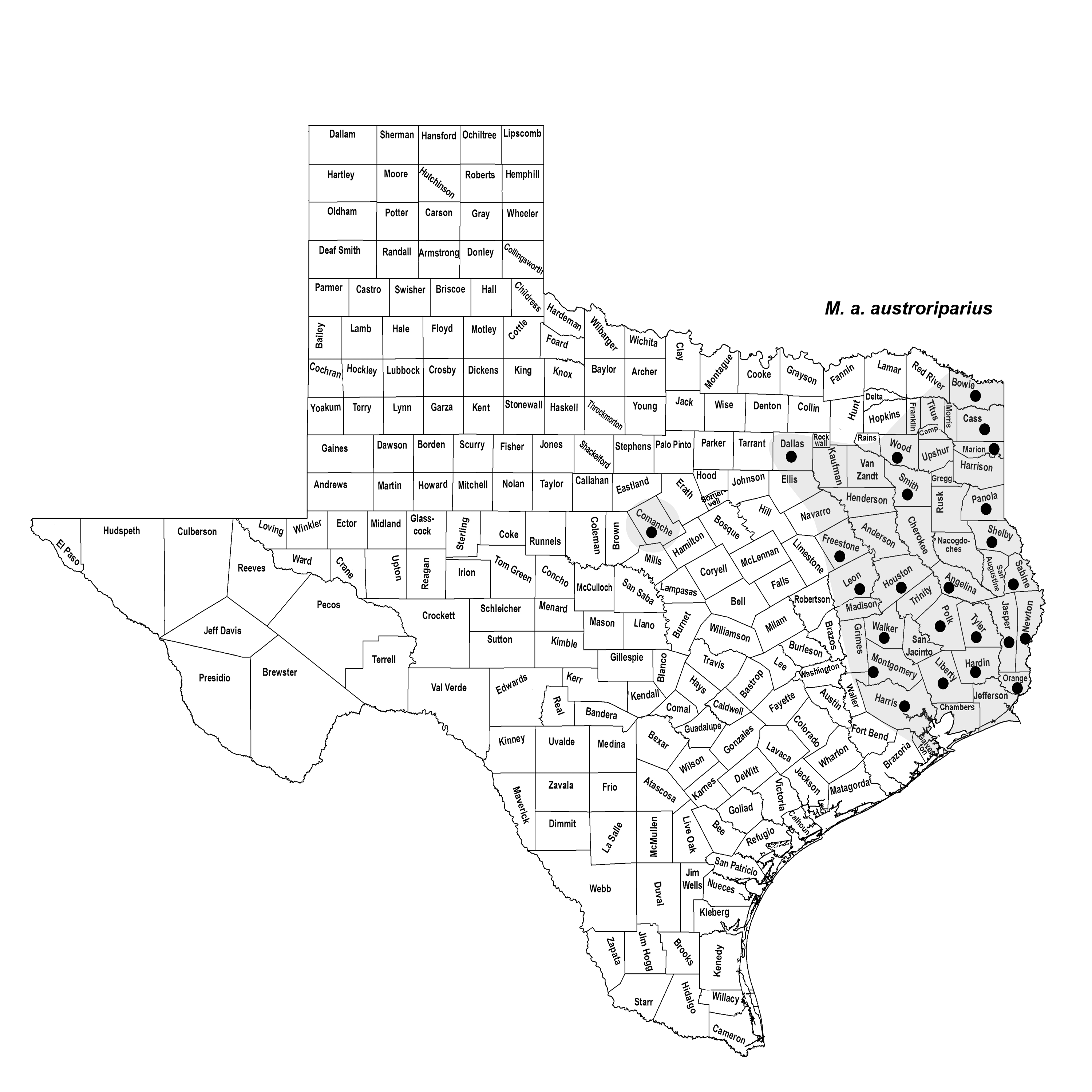SOUTHEASTERN MYOTIS
Myotis austroriparius (Rhoads 1897)
Order Chiroptera : Family Vespertilionidae
DESCRIPTION. A small bat with dense, dull, woolly fur; upperparts brownish to sooty; fur of underparts with white tips and black bases, the general white appearance contrasting sharply with the upperparts; cranium globose and normally with a low sagittal crest. Dental formula: I 2/3, C 1/1, Pm 3/3, M 3/3 × 2 = 38. Averages for external measurements: total length, 88 mm; tail, 36 mm; foot, 9 mm; forearm, 38 mm. Weight, 5–7 g.

DISTRIBUTION. This bat occurs in the southeastern United States, extending westward into eastern Texas where it was known previously only from the Pineywoods region. In 1996 three county records extended the range of this species westward to Leon, Freestone, and Walker counties, and a specimen collected in Comanche County in 1995 extended the known range of the species approximately 240 km (149 mi.) west in the state.

SUBSPECIES. Myotis a. austroriparius.
HABITS. Myotis austroriparius is predominantly a cave bat in that part of its range where suitable caves occur. In Texas, however, these bats roost primarily in live, hollow bottomland hardwood trees close to slow-moving rivers and in fabricated structures such as abandoned houses and culverts. When they leave their diurnal roosts late in the evening (usually about dark), they fly to nearby ponds and streams where they drink and forage. They fly low over the water, usually within 60 cm of the surface, capturing insects. Specific foods are not known, but small moths, midges, mosquitoes, and flies are probably of importance.
Where suitable caves are available, both males and females congregate in large numbers in late March and April to bear their young. In caveless areas, old buildings may serve as nursery sites. Parturition occurs in late April to late May, and the young are large enough to fly 5 or 6 weeks later. The southeastern myotis is unusual among bats of its genus as it usually gives birth to twin offspring (other Myotis usually bear only one young per year). At birth, the young bats weigh slightly >1 g each. They grow rapidly, and sexual maturity is reached in both sexes before the bats are 1 year old.
Their most important predators appear to be rat snakes, corn snakes, opossums, and certain species of owls. Large cockroaches may prey on newborn young that fall to the ground.
POPULATION STATUS. Uncommon, year-round resident. The southeastern myotis is uncommon in Texas as there are only 25 specimen records, primarily from the far eastern part of the state.
CONSERVATION STATUS. The IUCN status of the southeastern myotis is least concern. Previously it has been considered a species of concern by the USFWS; it is not included on the TPWD list. Also, at one time, the Texas Organization of Endangered Species (which no longer exists) listed it as a watch-list species because of perceived low population density. Although these bats now appear to be more abundant in Texas and Arkansas than was once believed, major declines in populations have been documented in other states over the past several decades, particularly in Florida, where most of the large maternity colonies are located. This species is considered endangered in Illinois, Indiana, and Kentucky, threatened in South Carolina, and a species of special concern in North Carolina. There has been speculation that this species could be threatened by clearing of bottomland hardwood habitats and by destruction of major cave roosting sites.
From The Mammals of Texas, Seventh Edition by David J. Schmidly and Robert D. Bradley, copyright © 1994, 2004, 2016. Courtesy of the University of Texas Press.
Natural Science Research Laboratory
-
Address
Museum of Texas Tech University, 3301 4th street, Lubbock, TX 79409 -
Phone
806.742.2486 -
Email
nsrl.museum@ttu.edu


